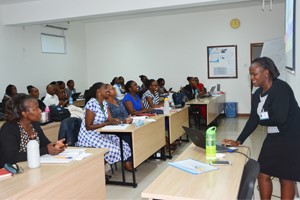The pedagogy of service learning
This story is written by Mary Oluga, Assistant Professor and Coordinator, MEd Part-Time Programmes, from Institue for Educational Ddevelopment Tanzania
In the last 30 years, I have taught learners ranging from primary school children to adults undertaking a Master in Education. Needless to say, my teaching philosophy has experienced a metamorphosis during this period. Today, I understand that the ultimate aim of education should be to develop an inquisitive mind, which, at the same time, seeks answers to questions raised by such a mind. This enables an individual to seek real answers that aim to improve society. This philosophy is intricately embedded in my teaching presently. Subsequently, as an educator, I often seek improvement for myself and others by engaging in reasoned thought.

Working with practitioners I always endeavour to encourage reasoning. One of the ways in which I have taught in this manner is through engaging my students in service-learning – “a teaching and learning strategy that integrates meaningful community service with instruction and reflection to enrich the learning experience, teach civic responsibility and strengthen communities” (Eyler et al., 2001). I have found it most appropriate because service-learning combines learning goals and community service in ways that enhance both student growth and the common good.
Teachers are often confronted with sensitive and controversial issues in their classrooms but are required to display a neutral and objective position. This is difficult and unreal. Hence, I have used both community service learning (CSL) and community-based learning (CBL) to deal with such issues. For example, with the former, my groups of MEd students went into a community to engage the latter in thinking of solutions to problems in the community. With CBL, groups of teachers and school administrators were brought into the institution and my group of master’s students facilitated a classroom-like workshop. Once, the students used interactive theatre to engage the community in discussing two social issues: abortion and female genital mutilation. In interactive theatre, the actors speak directly to the audience or engage them in actions, thus breaking the imaginary wall between the performers (students) and the audience (community). Both approaches often attract the attention of other staff and faculty. I attribute this to the spontaneous ways in which the strategies offer realistic solutions to realistic problems.
After every session of service-learning, I get the students to reflect on their learning. The lessons learnt by both the students and me help me improve on the structure of subsequent sessions.
While I recommend that educators should employ engaged pedagogies, I also recognise the challenge in "allowing the time" for this to take place. Elements of the intended outcome should be introduced gradually in the course or discipline taught. The course overview and objectives should state very clearly the purpose and justification for using service-learning, as this pedagogy has implications on time, money and other resource materials.
The outcomes of service-learning are immediate and are reflected in the attitudinal changes the students and community often share after such learning moments. The gains for the students are best captured by this comment from one of the MEd students after carrying out service-learning, “We do not have to wait until the end of school for our students to see the impact of our teaching.” Indeed, the comment applies to me, too. I live my teaching as my students live their learning.


